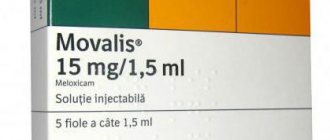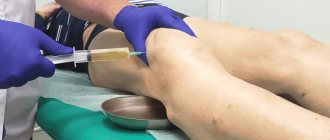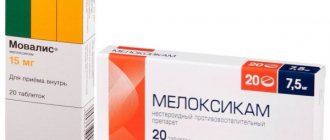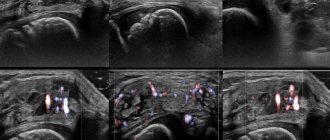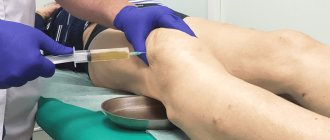Movalis is a non-steroidal anti-inflammatory drug that has a complex effect on all manifestations of inflammation. Gives anti-inflammatory, analgesic and antipyretic effect. The drug relieves unpleasant subjective sensations, and also breaks pathogenetic chains in the development of inflammatory reactions of various origins and localization. The main mechanism of action of meloxicam on inflammatory mediators is inhibition of prostaglandin synthesis.
Release form and composition
The drug Movalis is available in the form of tablets, injection solution and rectal suppositories. Each release form is more effective for certain pathologies.
Movalis tablets 15 mg, 10 or 20 pieces - contain the active ingredient meloxicam in an amount of 15 mg, as well as excipients: lactose monohydrate - 20 mg, sodium citrate dihydrate - 30 mg, MCC (microcrystalline cellulose) - 87.3 mg, povidone K25 - 9 mg, colloidal silicon dioxide - 3 mg, crospovidone - 14 mg, magnesium stearate - 1.7 mg.
Movalis tablets 7.5 mg, 10 pieces - contain the active ingredient meloxicam in an amount of 7.5 mg, as well as excipients: lactose monohydrate - 23.5 mg, sodium citrate dihydrate - 15 mg, MCC (microcrystalline cellulose) - 102 mg, povidone K25 - 10.5 mg, colloidal silicon dioxide - 3.5 mg, crospovidone - 16.3 mg, magnesium stearate - 1.7 mg.
Rectal suppositories Movalis 15 mg, 6 pieces - each suppository contains 15 mg of meloxicam and excipients: Suppocire BP solid fat, polyethoxylated ricin oil, hydrogenated.
Rectal suppositories Movalis 7.5 mg, 6 pieces - contain 7.5 mg of meloxicam and excipients: Suppocire BP solid fat, polyethoxylated ricin oil, hydrogenated.
Movalis injection solution 15 mg/1.5 ml, 3 or 5 ampoules - this release form includes meloxicam 15 mg, as well as excipients: meglumine, poloxamer 188, sodium chloride, sodium hydroxide E524, glycine E640, glycofurol, water for injection, sterile, up to 1.5 ml.
Oral suspension Movalis 7.5 mg/5 ml - 5 ml of the drug contains the active ingredient meloxicam 7.5 mg, as well as excipients: colloidal silicon dioxide - 50.00 mg, hyaetellose - 5.00 mg, sorbitol - 1750 .00 mg, glycerol - 750.00 mg, xylitol - 750.00 mg, sodium dihydrogen phosphate dihydrate - 100.00 mg, sodium saccharinate - 0.50 mg, sodium benzoate - 7.50 mg, citric acid monohydrate - 6.00 mg, raspberry flavor - 10.00 mg, purified water - 2463.50 mg.
pharmachologic effect
Pharmacodynamics
Movalis contains meloxicam, the main effect of which is the ability to block the synthesis and release of prostaglandins at each stage of their biochemical transformation. The ability to block COX-2, which is one of the main mediators of acute phase inflammation, stands out separately.
The effect of the drug is specific, so COX-1 is not inhibited, which reduces the number of side effects. The highest intensity of exposure is observed at the site of inflammation, and not in peripheral tissues.
It is noted that due to the confirmed high specificity, Movalis does not cause the classic side effect of non-steroidal anti-inflammatory drugs in the form of an effect on platelet aggregation, which avoids an increased risk of bleeding.
Pharmacokinetics
The drug has high bioavailability - 90%, absorption occurs completely in the intestine. The maximum concentration in blood plasma is achieved 5-6 hours after oral administration and 2-3 hours after the injection. Moreover, the bioavailability of injection forms is 100%. Absorption of the drug does not depend on food intake.
Meloxicam quickly passes into a chemically bound form, having a high affinity for proteins, in particular albumins. The binding rate is 99%. Active forms of the drug penetrate into the synovial fluid of the joint capsules, where the concentration is reduced by half compared to blood plasma. With prolonged and systematic use, the concentration in the synovial fluid increases.
The biotransformation of meloxicam occurs mainly in the liver with the participation of cytochromes of the CYP 2C9 and CYP 3A4 families. The toxicity of the drug does not increase during its metabolism; the 4 main metabolites are pharmacologically inactive and are excreted in the urine. Elimination occurs in feces and urine, about 5% of the substance is excreted unchanged.
Pharmacological properties of the drug Movalis
Pharmacodynamics. Meloxicam is an NSAID of the enolic acid class, has anti-inflammatory, analgesic and antipyretic effects. Meloxicam exhibits high anti-inflammatory activity in all standard models of inflammation. The mechanism of action is due to the ability to inhibit the biosynthesis of prostaglandins - mediators of inflammation due to the selective inhibition of COX-2, while providing a safer mechanism of action due to the selective inhibition of COX-2 compared to COX-1. It has now been proven that the therapeutic effect of NSAIDs is associated with inhibition of COX-2 synthesis, while inhibition of COX-1 leads to side effects from the stomach and kidneys. The selectivity of COX-2 inhibition by meloxicam has been confirmed by many researchers both in vitro and ex vivo . Meloxicam (7.5 and 15 mg) preferentially inhibits COX-2 ex vivo , as evidenced by greater inhibition of PGE2 production in response to lipopolysaccharide stimulation compared with clotted blood thromboxane (COX-1) production. These effects are dose dependent. Meloxicam does not affect platelet aggregation or bleeding time when used at recommended ex vivo , whereas indomethacin, diclofenac, ibuprofen and naproxen significantly inhibit platelet aggregation and increase bleeding time. Clinical studies have shown a low incidence of gastrointestinal side effects (perforation, ulceration and bleeding) when using meloxicam at recommended doses compared to standard doses of other NSAIDs. Pharmacokinetics. Meloxicam is well absorbed from the gastrointestinal tract when administered orally; The absolute bioavailability of the drug is 89%. Concomitant consumption of food does not affect the absorption of the drug. The concentration of the drug when taken orally is 7.5 and 15 mg per day, respectively, dose-dependent. A stable concentration is achieved on days 3–5. Continuous treatment over a long period (eg 6 months) did not lead to changes in pharmacokinetic parameters compared to parameters after 2 weeks of oral administration of meloxicam at a dose of 15 mg per day. Any changes are also unlikely if treatment lasts more than 6 months. More than 99% of meloxicam is bound to plasma proteins. The drug penetrates into the synovial fluid, its concentration there is 2 times lower than in the blood plasma. After intramuscular injection, meloxicam is completely absorbed, indicating its absolute bioavailability (almost 100%). The pharmacokinetics of meloxicam is linear and dose-dependent when administered intramuscularly in doses of 7.5 and 15 mg. The concentration of meloxicam in blood plasma reaches a maximum 60 minutes after intramuscular injection. Meloxicam undergoes extensive biotransformation in the liver. Meloxicam is almost completely metabolized to 4 pharmacological inert metabolites. The main metabolite, 5-carboxymeloxicam (60% of the dose), is formed by oxidation of the intermediate metabolite 5-hydroxymethylmeloxicam, which is excreted to a lesser extent (9% of the dose). In vitro studies suggest that CYP 2C9 plays an important role in metabolism, CYP 3A4 to a lesser extent. Peroxidase activity in patients is likely responsible for 2 other metabolites, which account for 16 and 4% of the dose received, respectively. Meloxicam is excreted, predominantly in the form of metabolites, in equal amounts in urine and feces. Less than 5% of the daily dose is excreted unchanged in the feces, while only traces of the unchanged substance are excreted in the urine. The half-life is about 20 hours. Hepatic and renal failure do not significantly affect the pharmacokinetics of meloxicam. Plasma clearance is 8 ml/min. Clearance decreases in older women. The volume of distribution is low, averaging 11 L. Individual deviations are 30–40% after IM application.
Indications for use of Movalis
The medicine is used to relieve symptoms of inflammation, including fever, pain, local swelling, and redness. The drug is especially effective in the symptomatic treatment of diseases of the musculoskeletal system, degenerative diseases of the skeleton and muscular system, with causalgic pain and other diseases. The main diseases that are indications for the use of Movalis, as well as dosages to achieve maximum therapeutic effect, are listed below. It is not recommended to exceed the dosage of 15 mg/day. Indications:
- Movalis for osteochondrosis is indicated for use in tablet form at 15 mg/day; with a decrease in symptoms, the dose can be reduced to 7.5 mg/day.
- Movalis for ankylosing spondylitis can be used at a dosage of 15 mg/day orally, but in patients with an increased risk from the cardiovascular system, the therapeutic dose should start at 7.5 mg/day and increase if necessary under the supervision of the attending physician.
- Movalis for neuralgia of any origin can be used symptomatically to relieve pain at a dose of 7.5 mg/day, one tablet once a day.
- Movalis for lower back pain is recommended only when local painkillers are not effective. In this case, a dose of 7.5 mg/day is recommended.
- For pinched nerves, Movalis is indicated for pain relief at a dose of 7.5 mg/day; you can use one tablet or one rectal suppository of 7.5 mg, respectively.
- Movalis for a spinal hernia with progressive pain syndrome, lumbago or lumbar ischialgia, an injection of Movalis 7.5 mg once or 15 mg tablet forms is indicated.
- Movalis for radiculitis is used in doses of 7.5 or 15 mg per day; if this dosage form is not effective, you can use injections of 15 mg once a day. The course of injection treatment should not last more than 3 days with a maximum daily dose of 15 mg.
- Movalis for arthritis, including rheumatoid origin, is used at 15 mg/day, one 15 mg tablet once in the morning or two 7.5 mg tablets in the morning and evening. In the presence of an acute attack of rheumatoid arthritis, injections may be used, but only in cases where tablet forms and suppositories cannot be used or are not effective. Movalis injections are limited to one injection of 15 mg/day.
The justification for using Movalis should be determined by a physician based on the specific pathological condition that can be treated. Dose adjustments are made based on the patient's feedback on how they feel, the reduction of symptoms, or the presence of adverse reactions.
Use of the drug Movalis
Tablets, suppositories In adults Osteoarthritis: tablets and suppositories are prescribed at the rate of 7.5 mg/day. If necessary, the dose can be increased to 15 mg/day (2 tablets or 1 suppository) 1 time per day. Rheumatoid arthritis: prescribed at the rate of 15 mg/day. When a therapeutic effect is achieved, the dose can be reduced to 7.5 mg/day. Ankylosing spondylitis: prescribed at a rate of 15 mg/day. When a therapeutic effect is achieved, the dose can be reduced to 7.5 mg/day. In patients with an increased risk of adverse reactions, the initial dose is 7.5 mg/day. In dialysis patients with severe renal impairment, the dose should not exceed 7.5 mg/day. Since increasing the dose and increasing the duration of treatment increases the risk of adverse reactions, it is necessary to use the drug in the minimum effective daily dose and with the shortest duration of treatment. Adolescents over 12 years of age: tablets and suppositories - the maximum recommended daily dose is 0.25 mg/kg. The maximum recommended daily dose of Movalis is 15 mg. Considering that the dose for children has not been established, the use of the drug should be limited only to adolescents over 12 years of age and adults. The tablet should be taken with food, without chewing, with water or other liquid. Injection solution: IM use should only be prescribed during the first few days of treatment. In the future, oral forms of the drug should be used to continue treatment. The recommended dose of Movalis for injection is 7.5 mg or 15 mg/day, depending on the intensity of pain and severity of inflammation. Since increasing the dose and increasing the duration of treatment increases the risk of adverse reactions, it is necessary to use the drug in the minimum effective daily dose with the shortest duration of treatment. Movalis should be administered by deep intramuscular injection. Given possible incompatibility, Movalis in the form of an injection solution cannot be mixed with other drugs in the same syringe. In patients with severe renal failure on dialysis, the dose should not exceed 7.5 mg/day. Movalis in the form of an injection solution should not be administered intravenously. Considering that the dosage regimen for children and adolescents under 15 years of age has not been established, the drug is recommended for the treatment only of adults and adolescents over 15 years of age. Combined use: the total daily dose of Movalis when used in the form of tablets and suppositories should not exceed 15 mg. The duration of treatment depends on the nature of the disease and the effectiveness of the therapy.
Contraindications
It is not recommended to take meloxicam in patients with developed sensitization to the components of the drug. Contraindicated in patients who have developed symptoms of asthma, swelling, nasal breathing problems or urticaria after taking non-steroidal anti-inflammatory drugs, including derivatives of acetylsalicylic and enolic acids. Taking Movalis is contraindicated:
- During the third trimester of pregnancy, the use of drugs based on meloxicam can lead to impaired blood circulation in the fetus, the development of cardiopulmonary failure, pathology of the urinary system, in particular progressive renal failure. During this same period, the medicine can have a detrimental effect on the course of labor.
- Pathology of the gastrointestinal tract, in the presence of gastric bleeding or perforation of an ulcer, especially if they are caused by the systematic use of a non-steroidal anti-inflammatory drug. A history of gastrointestinal bleeding requires recalculation of the dose and use of other classes of drugs.
- Severe liver failure is a direct contraindication, since the drug undergoes biotransformation with the participation of cytochromes and other liver enzymes. Taking Movalis for functional liver failure can lead to the development of complications.
- Severe renal failure without dialysis. It should be borne in mind that during peritoneal dialysis or hemodialysis the drug can be prescribed with caution, as its elimination will occur.
- Ages under 16 years are a direct contraindication to the use of Movalis due to the peculiarities of biotransformation and distribution of the drug, as well as the development of immediate allergic reactions in this age category. It is impossible to select a safe dose for use in such patients without the risk of adverse reactions.
- Disorders of the blood coagulation system, which are manifested by the presence of bleeding that is difficult to stop, a history of cerebrovascular bleeding and are confirmed by the results of laboratory tests.
- Severe heart failure.
- Simultaneous use of anticoagulants.
Contraindications of the drug
Advertising:
Despite the mild, gentle effect on the body, there are many contraindications to the drug. Intolerance to NSAIDs is common, and in some people it is severe. At the same time, bronchial asthma, urticaria, and nasal polyposis develop. Such reactions are a strict contraindication to the use of any NSAIDs.
You should not inject Movalis with an ulcer or erosion of the gastrointestinal tract, as well as with gastritis in the acute stage.
Crohn's disease and ulcerative colitis of the large intestine also serve as prohibitions on the use of the medicine. The drug has a weak effect on the kidneys, but in severe cases of renal failure it should not be used. Other contraindications:
- decompensated heart failure;
- active inflammatory liver disease;
- bleeding from the gastrointestinal tract, recent cerebral hemorrhages;
- severe diseases of the blood coagulation system;
- taking large doses of anticoagulants;
- pregnancy;
- lactation;
- age under 18 years;
- conditions after operations on large vessels.
Advertising:
They are treated with great caution with Movalis in the presence of chronic pathologies of the digestive tract without exacerbation, in moderate renal and heart failure, in diabetes mellitus, in elderly patients.
Side effects
Side effects are classified depending on the affected organs and systems, as well as by frequency of occurrence in a similar way: very common (1 case out of 10), frequent (1 case out of 100); uncommon (1 in 1000), rare (1 in 10,000), very rare (less than 1 in 10,000), unknown (no exact data on the frequency of occurrence).
From the immune system: infrequently - allergic reactions, urticaria, angioedema, polymorphic rash of allergic origin; unknown - anaphylactic reactions, anaphylactic shock.
From the mental side: rarely - mood swings, nightmares; unknown - disorientation, insomnia.
From the nervous system: often - headache; rarely - dizziness, drowsiness.
From the sensory systems: rarely - ringing in the ears, blurred vision, blurred vision; infrequently - dizziness, conjunctivitis.
From the cardiovascular system: infrequently - increased blood pressure; rarely - palpitations; unknown - heart failure associated with the use of non-steroidal anti-inflammatory drugs.
From the respiratory system: rarely - asthma in patients with allergies to acetylsalicylic acid and other non-steroidal anti-inflammatory drugs; unknown - cough.
From the gastrointestinal tract: often - dyspepsia, nausea, vomiting, abdominal pain, constipation, flatulence, diarrhea; uncommon - gastrointestinal bleeding, stomatitis, gastritis, belching; rarely - colitis, ulcer, esophagitis, abnormal laboratory tests of liver function; very rarely - hepatitis; unknown - liver failure.
From the skin and subcutaneous fat: infrequently - angioedema, itching, rash; rarely - Stevens-Johnson syndrome, toxic epidermal necrolysis, urticaria; very rarely - bullous dermatitis, erythema multiforme; unknown - photosensitivity, exfoliative dermatitis.
From the urinary system: uncommon - sodium and water retention, changes in electrolyte balance (hypokalemia), increased creatinine and/or urea in the blood plasma as a marker of decreased renal function; very rarely - acute renal failure; unknown—impaired urinary frequency.
General disorders and disorders at the injection site: often - hardening and pain at the injection site; infrequently - swelling.
Contraindications and side effects
Meloxicam, and therefore Movalis, has standard contraindications for NSAIDs. These include: individual intolerance, the manifestation of allergic reactions, the presence of an allergy to acetylsalicylic acid, and especially the occurrence of aspirin bronchial asthma. If a person has nasal polyposis in combination with aspirin-induced asthma, then NSAIDs in any form are strictly contraindicated for him.
Peptic ulcers of the stomach and duodenum, as well as erosive ulcerative gastritis, have already been discussed above. There are other contraindications, for example, pregnancy and breastfeeding, children under 12 years of age, decompensated heart and kidney failure, as well as ulcerative colitis, which is sometimes called Crohn's disease.
The shorter the course of use of Movalis, the lower the risk of various side effects. Leukopenia, drug-induced hepatitis, and various severe skin lesions, such as Lyell's syndrome, almost never develop. Various allergic reactions and headaches occur much more often, but in any case - no more often than in 10% of all cases.
Gastrointestinal bleeding can be a complication, but it can be easily avoided if the patient's history is collected before prescribing the drug, and if necessary, “covered up” with omeprazole.
It must be remembered that when prescribing Movalis, a second drug from the NSAID group is not prescribed; for example, it makes no sense to use Movalis and ketoprofen (Ketonal) together, and it would be a completely gross and dangerous mistake to prescribe Movalis together with diclofenac. It is also not compatible with drugs from the SSRI antidepressant group, and with some diuretics. A complete and detailed description of compatibility, side effects and contraindications can be read in the official instructions for the drug.
Overdose
In case of an overdose of the drug Movalis, no specific manifestations are observed. If the permissible dosage of 15 mg/day is exceeded, the likelihood of developing side effects of meloxicam significantly increases.
The main signs of overdose are general malaise, weakness, nausea, vomiting, pain in the epigastric region, defecation disorders, loss of appetite, sweating, tremor, drowsiness or insomnia, itching, palpitations, tachycardia, increased symptoms of the underlying disease.
Overdose cannot be treated due to the lack of a specific antidote. It is recommended to evacuate gastric contents, take absorbent drugs or prokinetics, drink large amounts of fluid, and stimulate the gag reflex. It is worth considering that the elimination and metabolism of meloxicam can be accelerated by taking cholestyramine.
Application in medical practice
Single dose oral meloxicam for acute postoperative pain in adults
Pain usually occurs after surgical procedures. The condition is usually used to test whether drugs are effective pain relievers in patients with moderate to severe pain. In this case, no studies were found that tested oral meloxicam against placebo. It is possible that studies were done but not reported because they were only used to register meloxicam with licensing authorities around the world. However, this leaves an important gap in our knowledge and means that we cannot be confident in the use of oral meloxicam for acute painful conditions.[1][2]
Interaction
The drug Movalis is capable of interacting with drugs at the pharmaceutical, pharmacokinetic and pharmacodynamic stages. Complex mechanisms of distribution and molecular effects on inflammatory mediators can lead to some unexpected effects that should be taken into account when taking the drug Movalis.
Milgamma and Movalis are used to relieve pain in osteochondrosis and a number of other diseases of the musculoskeletal system and bone tissue. It is not recommended to mix two medications in one syringe; this is fraught with interaction at the pharmaceutical stage and a chemical reaction between the components of the drugs. Injections of drugs should be carried out at different times, with an interval of at least 3 hours, but in general, the use of these drugs in combination has the desired therapeutic effect without dangerous consequences.
Combilipen and Movalis are recommended for use in the treatment of degenerative diseases of the nerve processes of various origins, which are accompanied by pain. B vitamins contained in the drug Combilipen enhance the effect of meloxicam-based drugs and cause an improvement in the patient’s well-being.
Diprospan and Movalis are not recommended for simultaneous use, as this significantly increases the risk of gastrointestinal bleeding and ulcer perforation due to synchronous inhibition of COX 1 and 2 - Diprospan is a glucocorticoid with a strong immunosuppressive effect, which also affects the gastric and intestinal mucosa.
Alflutop and Movalis can be prescribed simultaneously for the treatment of joint diseases, where Alflutop will produce a chondroprotective effect, and Movalis will relieve pain and inflammation. Also, taking them can normalize electrolyte disturbances caused by taking Movalis.
Movalis and Sirdalud, when used simultaneously, reduce each other's effects, being antagonists. Sirdalud is an adrenergic receptor agonist that reduces the effectiveness of non-steroidal anti-inflammatory drugs.
Movalis and Nimesil are contraindicated for simultaneous use due to inhibition of the same chains of prostaglandin synthesis, which increases the risk of complications and a decrease in the coagulant properties of the blood, which can lead to bleeding.
Movalis and Ketonal are contraindicated for simultaneous use, because Ketonal is a non-selective inhibitor of COX 1 and 2, which has a detrimental effect on the mucous membrane of the stomach and intestines, especially with the use of Movalis.
Movalis and Analgin, when used simultaneously, can cause hypothermia and changes in the blood system, in particular agranulocytosis.
Indications for injections
Advertising:
The main indications for the use of Movalis in injections are diseases of the musculoskeletal system of inflammatory origin. Among the pathologies of the spine, injections are prescribed for osteochondrosis of the cervical and lumbar spine, for osteochondrosis and scoliosis of the thoracic segment. Other indications from the spinal column:
- spondylitis;
- spondyloarthrosis;
- radiculitis;
- sciatica, lumbago;
- protrusion and hernia;
- disc prolapse;
- Bekhterev's disease;
- spinal osteoporosis;
- fractures and other vertebral injuries.
WE RECOMMEND THE ARTICLE!
Indomethacin suppositories are prescribed as an anesthetic. Read more >>
In addition, Movalis injections are prescribed as a means of symptomatic therapy and to relieve exacerbations of rheumatoid arthritis, psoriatic arthritis, and infectious joint lesions. The drug helps reduce pain and stiffness in degenerative joint disease - arthrosis, especially in coxarthrosis and gonarthrosis. A course of treatment with Movalis will eliminate the pain of gout and gouty arthritis caused by it. In adolescents, the medicine is indicated for juvenile arthritis.
Meloxicam is rapidly absorbed after administration, availability is 100%. The maximum concentration in the blood is reached within an hour. The medicine penetrates well into the synovial fluid, which accounts for its powerful effect on the joints. The active substance is processed by the liver and excreted in feces and urine.
With diabetes, patients are forced to take glucose-lowering medications if the diet can no longer provide the desired effect. A popular and affordable remedy is Metformin and its analogue Gliformin. Read more in the article: “Which is better gliformin or metformin.”
Analogues of Movalis
There are many analogues of the drug Movalis in terms of their effect, which can be used to treat the same diseases. However, there are some differences in doses, indications and application features that need to be taken into account.
Which is better: Movalis or Diclofenac?
Diclofenac is in many ways more convenient to use due to the presence of other forms of release, especially gel. This allows Diclofenac to be used topically to relieve symptoms of inflammation. But the bioavailability of Movalis is much higher due to the ability to administer the drug intramuscularly. Movalis also penetrates better into the synovial fluid. When treating diseases of traumatic origin, bruises and injuries, it is recommended to use Diclofenac as a drug with fewer side effects. But in the treatment of rheumatological diseases, Movalis has an advantage.
Which is better: Movalis or Meloxicam?
The active ingredient of Movalis is Meloxicam, so their action is similar at the pharmacodynamics stage, but the pharmacokinetics of the drugs may differ due to the balanced composition of excipients that ensure the structural integrity of Movalis and its rapid accumulation in the blood serum. Elimination of drugs occurs in a similar way. For the most part, the difference between them is only in the release forms and dosage.
Which is better: Movalis or Amelotex?
They also have the same active ingredient - meloxicam. But the bioavailability in the case of Amelotex is several percent lower than that of Movalis, and the maximum dose in the blood serum increases more slowly. The indications and dosages of these drugs are identical. When taking Amelotex, bronchospasm is also possible, which is a rare side effect.
Which is better: Movalis or Arcoxia?
Arcoxia based on etoricoxib is a selective COX 2 inhibitor, which provides reduced side effects compared to non-selective inhibitors. The indications for use of these drugs are similar, but the release forms and dosages differ. Arcoxia also has a more pronounced analgesic effect, which is used to relieve acute postoperative pain syndrome. Etoricoxib in Arcoxia causes fewer side effects than Meloxicam if the permissible daily dosage is exceeded.
Which is better: Movalis or Mydocalm?
Mydocalm is a centrally acting muscle relaxant, which is strikingly different from Movalis in its mechanism of action. Indicated for the treatment of pathologies of the muscular system, while Movalis is more effective for the treatment of pathologies of bone tissue and joints. Also, the bioavailability of Mydocalm is several times lower and amounts to 20%, but the drug can be prescribed to patients with renal failure, because about 90% of metabolism and elimination occurs in the kidneys.
Which is better: Movalis or Nimesil?
Nimesil is more suitable for the treatment of headaches of any origin, pain from bruises and injuries, and reduction of temperature during systemic inflammation. But Nimesil therapy is not effective in the treatment of rheumatic pathology. The action of Nimesil occurs faster, but its elimination proceeds just as quickly.
Which is better: Movalis or Xefocam?
Xefocam is better suited for relieving pain of mild to moderate intensity, while the effect of the drug does not last long, although it begins within a few minutes after administration. Xefocam has a more pronounced analgesic effect than an anti-inflammatory one. Movalis, on the other hand, is a more complex drug that can relieve severe pain and relieve symptoms of inflammation, and with prolonged use it accumulates and the effect of the drug can last quite a long time.
Which is better: Movalis or Voltaren?
Voltaren is a drug based on diclofenac, which is convenient due to its rapid absorption, a wide selection of dosage forms, including for local use in the form of a gel, as well as a pronounced analgesic effect. The range of applications for Voltaren is much wider; it is used to treat surgical, neurological, and gynecological pathologies, while Movalis has a somewhat narrower range of applications.
Which is better: Movalis or Artrosan?
Both drugs are based on meloxicam and have the same doses to achieve the desired therapeutic effect. However, Artrosan can be used from 15 years of age, while Movalis - from 16 years of age.
Which is better: Movalis or Dexalgin?
Dexalgin has a different mechanism of action; it inhibits the conversion of arachidonic acid to thromboxanes and prostaglandins. A noticeable analgesic effect after administration occurs within half an hour and can last up to 6 hours. Dexalgin is also highly effective in the treatment of rheumatic diseases. It can be used to relieve toothache or pain during menstruation, for which Movalis cannot be used.
Which is better: Movalis or Aertal?
Aertal contains aceclofenac, which has a pronounced antipyretic, anti-inflammatory and analgesic effect. Unlike Movalis, Airtal non-selectively inhibits COX 1 and 2, which, when used systematically, can lead to a large number of side effects not characteristic of Movalis, such as bleeding and peptic ulcers.
Which is better: Movalis or Nimesulide?
Nimesulide is developed on the basis of Nimesil and differs only in a large selection of release forms. It is effective for short-term pain relief, but is not able to comprehensively influence the pathogenetic mechanisms that lead to rheumatic damage to organs and systems. The action of Nimesulide is more general and generalized; it can be used to relieve headaches and to achieve an antipyretic effect for colds and acute respiratory viral infections. The action of Movalis is more specific for damage to the musculoskeletal system.
Content
- 1 Use in clinical practice 1.1 Single dose oral meloxicam for acute postoperative pain in adults
- 2.1 Cardiovascular side effects
- 6.1 Pregnancy and lactation
- 9.1 Pharmacokinetics
Compatibility of Movalis and alcohol
The simultaneous use of Movalis and alcohol is not recommended and may lead to a decrease in the desired therapeutic effect of the drug, the appearance or intensification of side effects and other undesirable consequences. Alcohol is an inhibitor of liver biotransformation enzymes, which are also involved in the metabolism of meloxicam. Because of this, competitive inhibition of cytochrome P450 and its subfamilies is possible, which will lead to increased hepatotoxicity of the drug and ethanol, a decrease in the rate of metabolism and elimination of the drug.
Alcohol's change in the rheological properties of blood, in particular the effect on the surface tension of the liquid fraction and changes in osmotic pressure, can lead to unpredictable pathophysiological effects on the part of the kidneys at the filtration stage. Movalis is excreted by the kidneys, so drinking alcohol may slow down the elimination of metabolites of the active substance from the body.
Data on the mechanisms of interaction between meloxicam and ethanol are incomplete; they may occur at the pharmacokinetic (distribution stage) and pharmacodynamic (final effect stage) stages. The results of such interactions may be unpredictable.
During pregnancy
The use of Movalis during pregnancy, lactation, and breastfeeding is strictly contraindicated. Due to the characteristics of the chemical structure and distribution in biological fluids, the components of the drug penetrate into breast milk.
Since Movalis affects the arachidonic acid cascade, COX and prostaglandins, there is an indirect effect of the drug on fertility. It reduces fertility and may cause delayed ovulation; therefore, the drug is not recommended when preparing for pregnancy. This should be taken into account when taking the medicine to women who are at the stage of planning pregnancy, as well as in the early stages. If you have taken the drug before, it is recommended to discontinue it.
In early pregnancy, prostaglandin synthesis inhibitors statistically significantly increase the chance of miscarriage by 1-1.5%. The risk directly correlates with the dose of the drug and the duration of its use.
There is evidence of the effects of meloxicam on the fetus in the third trimester, which can lead to manifestations of cardiopulmonary toxicity with the development of congenital defects and progressive renal failure in the child.
For the mother's body, meloxicam can be harmful due to the prolongation of contractions and their weakening, which leads to a delay in labor. Possible prolongation of postpartum bleeding time.
Use in veterinary medicine
Meloxicam is used in veterinary medicine, most commonly in dogs and cats, but also allows off-label use in other animals such as cattle and exotic animals.[13][14] Side effects in animals are similar to side effects in humans; The main side effect is gastrointestinal irritation (vomiting, diarrhea and ulceration). Less common but important side effects include liver and kidney toxicity.
No perioperative cardiovascular adverse effects have been reported in healthy dogs treated with meloxicam at recommended doses.[15] Perioperative administration of meloxicam to cats had no effect on postoperative respiratory rate or heart rate.[16] The peer-reviewed journal article cited NSAIDs, including meloxicam, as causing gastrointestinal distress and, at high doses, acute renal failure and CNS symptoms such as seizures and comas in cats. He adds that cats have low resistance to NSAIDs.[17][18]Meloxicam has been investigated as an alternative to diclofenac RSPB to prevent the death of vultures.
Pharmacokinetics
In dogs, the absorption of meloxicam from the stomach is independent of the presence of food[19] with the peak concentration (Cmax) of meloxicam occurring in the blood 7-8 hours after administration.[19] The half-life of meloxicam is approximately 24 hours in dogs.[19] In koalas (Phascolarctos cinereus), very little meloxicam is absorbed into the blood after oral administration (i.e., it has low bioavailability).[20]
Legal status
United States
Since 2003, meloxicam has been approved in the United States for use in dogs to treat pain and inflammation associated with osteoarthritis, as an oral (liquid) formulation of meloxicam.[21] In January 2005, the product insert added a bold warning: "Do not use in cats."[22]An injectable drug for use in dogs was approved by the US Food and Drug Administration in November 2003.[23]In October 2004, the drug for use in cats has been approved for use only after surgery.[24] It is an injectable meloxicam labeled as a single, one-time dose, with specific and repeated warnings not to administer a second dose.[25]
In 2005, the US Food and Drug Administration issued an infringement notice to the manufacturer for its advertising materials, which included advertising the drug for off-label uses.[26]
European Union
In Europe, where the product has been available since the early 1990s, it is licensed for other anti-inflammatory benefits, including relief of both acute and chronic pain in dogs. In June 2007, an oral version of meloxicam was licensed for long-term pain relief in cats. Meloxicam is also licensed for use in horses to relieve pain associated with musculoskeletal disorders.[27]
Other countries
As of June 2008, meloxicam is registered for long-term use in cats in Australia, New Zealand and Canada.
